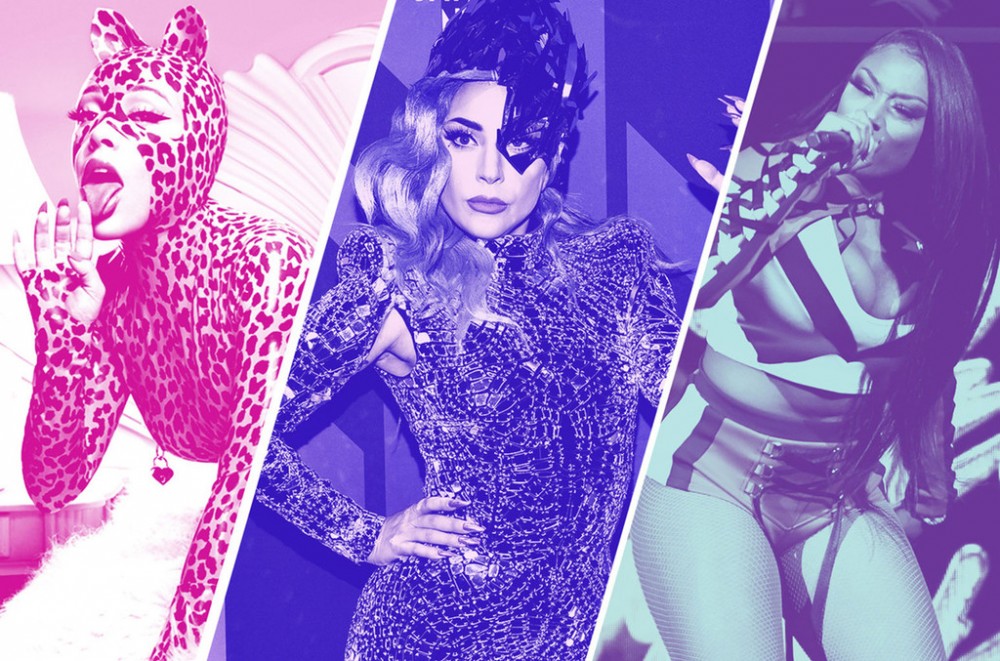
In the past six weeks, there’s been an unusual amount of turnover atop the Billboard Hot 100 chart — and within that whiplash of new No. 1s, what’s even more notable is the frequency of women dominating the top spot.
After a half-year run of male stars at the apex of the chart, we finally saw three all-female collaborations top the Hot 100 in the span of one month — an impressive feat on its own, and even more so when you consider that there have been just five total in the 62 years of the chart’s history before that.
First, Doja Cat and Nicki Minaj’s bubbly “Say So” climbed to No. 1 on the May 16 chart, following the first week of tracking for the Minaj remix (which was released May 1). Then Megan Thee Stallion and Beyoncé’s heater “Savage” rose to No. 1 on the May 30 chart, about a month after its Queen Bey remix arrived. Finally, Lady Gaga and Ariana Grande’s instant dancefloor classic “Rain on Me” debuted at No. 1 on the June 6-dated chart, following its first week of release.
So why did it take so long — and will the all-female hit collab become common enough from now on that we no longer have to pay special attention to such an occurrence?
“There is absolutely a cultural shift happening — I don’t think it’s coincidental,” Jill Strada, director of operations for Cox Media Group’s Miami Radio, says of the trio of No. 1s in such a short window. “I believe that female artists have earned respect in the game, and are now getting the positive recognition they deserve.”
To get their respective songs to No. 1, each label involved (Megan Thee Stallion’s 300 Entertainment, Beyonce’s Parkwood Music, Doja Cat’s RCA, Nicki Minaj and Ariana Grande’s Republic Records and Lady Gaga’s Interscope Records) followed a unique roadmap. But one thing that they all had in common on their side? Star power.
“Savage” and “Say So” were already bona fide hits — “Savage” was top 10 on the Hot R&B/Hip-Hop Songs chart, while “Say So” had topped the Rhythmic Songs chart and reached No. 3 on Pop Songs — but the added prowess of Beyoncé and Nicki Minaj pushed them over the top. “We got Beyoncé on the song, and we watched it go into another stratosphere,” 300 Entertainment svp Aimie Vaughan-Früehe says of the “Savage” Beymix. “It was already big, but this made it a moment, and it’s still exploding. It hasn’t let off the gas since.”
And while Queen Bey had experienced a bit of a dry spell in terms of crossover hits recently — The Carters single “Apes–t” marked her only appearance in the top 40 in the past two years — her verses on “Savage” turned out to be exactly what radio audiences wanted to hear. “I remember getting the remix sent to me and got it on the radio immediately,” Strada says. “I felt the excitement in knowing the song just went to another level with Beyoncé jumping on it.”
For Doja Cat, her race to No. 1 (the “Savage” remix was released on April 29, the “Say So” remix two days later) was aided by her and Nicki Minaj’s fervent fans who, RCA co-president John Fleckenstein says, are actually what led to the team-up in the first place. “We started to pay close attention to the fan chatter around Doja and Nicki,” he says of the initial conversations around Doja seeking a collaborator. “It was very obvious: we knew Doja was a Barb herself, and when you looked at all the comments and fan chatter, there was this intense [desire] for Nicki and Doja to do something together.”
Once Minaj’s version was unleashed on May 1, RCA co-president Joe Riccitelli cites the streaming and sales surges in the tracking week ending May 7, thanks to the Barbz and Doja’s fans, that propelled “Say So” to No. 1 on the Hot 100. “Both of those fan clubs really went out there and worked it hard,” Riccitelli says. The “Savage” remix was also a sales hit — never underestimate The Beyhive — and earned Megan Thee Stallion her first Digital Song Sales No. 1.
Aside from gaining a whole new streaming audience with the two remixes, each artist counted on robust radio support, too. 300 promo guru Shadow Stokes credits programmers like Strada and iHeartRadio’s Thea Mitchem for their loyalty to “Savage,” both before and after Beyonce joined the track. “It was just perseverance. We stuck with it, and [radio stuck] with it. It was really a collective effort,” he says, emphasizing that as an independent label, it was all hands on deck at 300. RCA also landed a coveted push with iHeartRadio in the form of Doja Cat’s “Say So” being chosen for the On The Verge program, which is when iHeartMedia’s radio stations play a song with greater frequency. “That helped us manage our way through it, and we felt really confident we were going to go all the way,” says RCA’s Joe Riccitelli.
“Rain on Me,” too, was an immediate hit with radio audiences. “Lady Gaga and Ariana Grande [are] two of the most powerful voices in the world coming together,” says Mitchem, executive vice president of programming at iHeartMedia. “With Gaga missing from the musical landscape since A Star Is Born, the world was ready to welcome Gaga home, and who better to open the door than Ariana Grande? That is what collaborations should be.” Again, fan excitement was also key, as Arianators and Little Monsters helped “Rain on Me” top Digital Song Sales with a strong first week, and earned Gaga her best Streaming Songs showing (No. 2) since 2013.
Almost every party agrees that while it’s important to highlight that there are six women behind these three No. 1s, this phenomenon shouldn’t be seen as a novelty that’s not likely to repeat. “Cream rises to the top,” Vaughan-Früehe believes, asserting that the industry is becoming more open to the concept that women can be hitmakers, too — no caveats necessary. “It’s no longer, ‘Oh, that’s a female record,’ it’s just a good record.”
“I’m not looking at these songs as ‘female collaborations’ — these are just really great songs by female artists, and I would like to think that my radio programming peers are looking at it in the same way,” Strada agrees. “These are major artists collaborating and making incredible music together — Lady Gaga and Ariana Grande, huge! Nicki Minaj jumping on Doja Cat’s song is fire! Meg and Beyoncé: next level!”
That mindset is being reflected in writer’s rooms, too. “I’ve definitely seen a shift,” says Nija Charles, who wrote “Rain on Me” with Grande, Gaga, Rami, BURNS, Tchami, BloodPop and Boys Noize. “A lot of the co-writers that I collaborate with are women, and they have a lot of No. 1 hits,” she adds, citing superstar writers like Tayla Parx, Victoria Monet and Ester Dean.
Women didn’t use to “collaborate all the time,” Charles remembers, especially on the rap side. Hits like “Say So” and “Savage” — which combined to mark the first time when four black female solo artists have occupied the Hot 100’s top two, for the week of May 16 — have now set the stage for more, more, more. “We’re finally opening that door to invite, or accept, female rappers, and have them at the top of their game,” she says.
When women of Beyoncé or Lady Gaga’s caliber land No. 1s, everyone wins; it not only whets the appetite of the industry, but creates a standard for the new generation of artists and songwriters, like Charles and her peers, to match and even exceed. “I think that is going to be a trickle-down effect, or a domino effect, of a bunch more females sticking together,” Charles says. “I love this new shift that we’re in.”
Strada looks at it as a healthy competition. “These ladies have established the groundwork, and now that there is a solid foundation set, we should expect new levels of greatness,” she says. “We all want to outdo what we did last, we want to hold the new title, so to speak…[it] only brings about limitless opportunities.”
Though the gender parity issues on the charts — particularly with hip-hop — are far from fixed, an event such as this one is exciting, because it gets us closer to a place where women can hop on a song together and it’s not viewed as anything other than normal. “I do think it’s a bit of a bellwether moment in a way. To see so many No. 1s come in such a short period of time, it really proves, ‘Okay, we need to recognize the fact that there are these forces here, and they need to be heard,’” Fleckenstein says. “This has drawn a lot of attention to something that, at least for a few weeks, we should feel good about the fact that it’s possible.”


 52
52